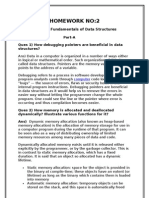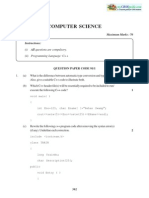03-24-14 Dyn Mem Allo & Linked List
03-24-14 Dyn Mem Allo & Linked List
Uploaded by
theyaimsCopyright:
Available Formats
03-24-14 Dyn Mem Allo & Linked List
03-24-14 Dyn Mem Allo & Linked List
Uploaded by
theyaimsOriginal Description:
Copyright
Available Formats
Share this document
Did you find this document useful?
Is this content inappropriate?
Copyright:
Available Formats
03-24-14 Dyn Mem Allo & Linked List
03-24-14 Dyn Mem Allo & Linked List
Uploaded by
theyaimsCopyright:
Available Formats
Announcements
Lecture 23
Assignment 5 due on Friday
Topics for today
Dynamic memory allocation/2
Linked lists/1
Memory Allocation Functions
The <stdlib.h> header declares three memory
allocation functions:
mallocAllocates a block of memory but doesnt
initialize it.
callocAllocates a block of memory and clears it.
reallocResizes a previously allocated block of
memory.
These functions return a value of type void *
a generic pointer that could point to any type of
data object
It points to the block just allocated
The malloc Function
malloc() - allocates a block of size bytes on the heap and
returns a pointer to it:
void *malloc (size_t size); /* size is # of bytes needed */
mallocs return value can be stored in a variable of any pointer
type
When malloc cannot locate a memory block of the requested
size, it returns a NULL pointer (which you can test for).
int *p;
p = malloc(sizeof(int)); /* allocate memory for an int now */
if (p == NULL) { /* handle bad allocation error */ }
else *p = 0; /* a good idea to initialize its value */
Dynamically Allocated Strings
Dynamic storage allocation is often useful for
working with strings.
Strings are stored in character arrays, and it can
be hard to anticipate how long these arrays need
to be.
By allocating strings dynamically, we can
postpone the decision until the program is
running.
4
Dynamically Allocated Strings
malloc is especially useful to allocate enough
space for the result of a string operation:
E.g. dynamic concatonation
char *s1, *s2, *result;
/* assume s1 and s2 get string values */
result = malloc(strlen(s1)+ strlen(s2) + 1);
strcpy(result, s1);
strcat (result, s2);
dont forget to include room for the null character at
the end of a string.
Using Dynamic Storage Allocation
in String Functions
Dynamic storage allocation makes it possible
to write functions that return a pointer to a
new string.
For example writing a function that concatenates
two strings without changing either one.
The function will measure the lengths of the two
strings to be concatenated, then call malloc to
allocate the right amount of space for the result.
And then perform the operation and return a
pointer to the new string result
Dynamic Concatonation Fcn
char *concat(const char *s1, const char *s2)
{
char *result;
result = malloc(strlen(s1) + strlen(s2) + 1);
if (result == NULL)
{
printf("Error: malloc failed in concat\n");
getchar( );
exit(EXIT_FAILURE);
}
strcpy(result, s1);
strcat(result, s2);
return result;
}
A call of the concat function:
char *p;
p = concat("abc", "def");
Using Dynamic Storage Allocation
in String Functions
When the string that concat returns is no
longer needed, well want to call the free
function to release the space that the string
occupies.
void free (void *ptr);
E.g. from the last slide - free(p);
If we dont, the program may eventually run
out of heap memory.
Memory leaks
If we allocate memory but don't free it this is
called a "memory leak"
void my_function (void)
{
int *a;
a= malloc(100*sizeof(int));
/* Do something with a*/
/* Oops forgot to free (a); */
}
Every time we call this function it "steals" 100 ints worth of
memory. Why??
As we call this function more and more the heap memory
will fill up with unusable fragments.
Dynamically Allocated Arrays
Dynamically allocated arrays have the same
advantages as dynamically allocated strings.
The close relationship between arrays and pointers
makes a dynamically allocated array as easy to use
as an ordinary array.
Although malloc can allocate space for an array,
the calloc function is sometimes used instead,
since it initializes the memory that it allocates.
10
Using malloc to Allocate Storage for an Array
Suppose a program needs an array of n
integers, where n is computed during program
execution.
Well first declare a pointer variable:
int *a;
Once the value of n is known, the program can
call malloc to allocate space for the array:
a = malloc(n * sizeof(int));
Always use the sizeof operator to calculate
the amount of space required for each element.
Using malloc to Allocate Storage for an Array
We can now ignore the fact that a is a pointer
and use it instead as an array name
thanks to the relationship between arrays and
pointers in C.
For example, we could use the following loop
to initialize the array that a points to:
for (i = 0; i < n; i++) a[i] = 0;
We also have the option of using pointer
arithmetic instead of subscripting to access
the elements of the array.
12
The calloc Function
The calloc function is an alternative to
malloc.
Prototype for calloc:
void *calloc(size_t nmemb, size_t size);
Properties of calloc:
Allocates space for an array with nmemb
elements, each of which is size bytes long.
Returns a null pointer if the requested space isnt
available.
Initializes allocated memory by setting all bits to 0.
13
The calloc Function
A call of calloc that allocates space for an array a
of n integers:
int *a;
a = calloc(n, sizeof(int));
And then set the value of each element from input
printf("Enter each array element: ");
for (i = 0; i < n; i++)
{printf(next value:);scanf("%d", &a[i]);}
By calling calloc with 1 as its first argument, we can
allocate space for a data item of any type:
struct point{ int x, y; } *p;
p = calloc(1, sizeof(struct point));
The realloc Function
The realloc function can resize a previously
dynamically allocated array.
Prototype for realloc:
void *realloc(void *ptr,size_t newsize);
ptr must point to a memory block obtained by a
previous call of malloc, calloc, or realloc.
newsize represents the new size of the block, which
may be larger or smaller than the original size.
The realloc function allows us to make an array
grow or shrink as needed.
The realloc Function
Properties of realloc:
When it expands a memory block, realloc
doesnt initialize the bytes that are added to the
block.
If realloc cant enlarge the memory block as
requested, it returns a null pointer; the data in the
old memory block is unchanged.
If realloc is called with a null pointer as its first
argument, it behaves like malloc.
If realloc is called with 0 as its second
argument, it frees the memory block.
The realloc Function
We expect realloc to be reasonably efficient:
When asked to reduce the size of a memory block,
realloc should shrink the block in place.
realloc should always attempt to expand a memory
block without moving it.
If it cant enlarge a block, realloc will allocate a new
block elsewhere, then copy the contents of the old
block into the new one.
Once realloc has returned, be sure to update all
pointers to the memory block in case it has been
moved.
Deallocating Storage
Memory allocation functions obtain memory
blocks from the heap.
Calling these functions too oftenor asking
them for large blocks of memorycan
exhaust the heap, causing the functions to
return a null pointer.
To make matters worse, a program may
allocate blocks of memory and then lose track
of them, thereby wasting space.
Deallocating Storage
Example:
p = malloc();
q = malloc();
A snapshot after these two statements have
been executed:
What happens when we do:
p = q;
Deallocating Storage
After q is assigned to p, both variables now
point to the second memory block:
There are no pointers to the first block, so
well never be able to access it again.
Deallocating Storage
A block of memory thats no longer accessible
to a program is said to be garbage.
A program that leaves garbage behind has a
memory leak.
Some languages (e.g. Java) provide a
garbage collector that automatically locates
and recycles garbage, but C doesnt.
Instead, each C program is responsible for
recycling its own garbage by calling the free
function to release unneeded memory.
The free Function
Prototype for free:
void free(void *ptr);
free will be passed a pointer to an unneeded
memory block:
int *p, *q;
p = malloc(sizeof(int));
q = malloc(sizeof(int));
free(p);
p = q;
Calling free releases the block of memory
that p points to.
22
The Dangling Pointer Problem
Using free leads to a new problem: dangling pointers.
free(p) deallocates the memory block that p points to,
but doesnt change p itself.
If we forget that p no longer points to a valid memory
block, chaos may ensue:
char *p = malloc(4);
free(p);
strcpy(p, "abc"); /*** WRONG ***/
Modifying the memory that p points to is a serious error.
Dangling pointers can be hard to spot, since several
pointers may point to the same block of memory.
When the block is freed, all the pointers are left
dangling.
Dangling Pointers
Watch out for dangling pointers/2
int *p, *q;
p = malloc(sizeof(int));
q = p;
free(p); /* frees block both point to */
*q = 0; /* error */
Linked Lists
Dynamic storage allocation is especially useful
for building lists, trees, graphs, and other
linked data structures.
A linked list consists of a chain of structures
(called nodes), with each node containing a
pointer to the next node in the chain:
The last node in the list contains a null pointer.
We use another pointer to point to the first
node
first
Linked Lists
A linked list is more flexible than an array: we
can easily insert and delete nodes in a linked
list, allowing the list to grow and shrink as
needed, without having to move data around.
On the other hand, we lose the direct access
capability of an array:
Any element of an array can be accessed in the
same amount of time via an index.
Accessing a node in a linked list is fast if the node
is close to the beginning of the list, slow if its near
the end. We have to traverse the list for search.
Linked Lists
A node in a linked list might have the following
definition:
struct node
{ int data;
struct node *next; /* references next node in chain*/
};
. . .
struct node a, b, *first; /* variables */
The use of a struct tag is mandatory, since the node
structure contains a reference to itself.
first = &a;
a.data = 100;
a.next = &b;
b.data = 50;
b.next = NULL;
a b
100 first 50
Selection shortcut
Because pointers often point to structures, C
provides a special notation (the right arrow selection
operator ->) for selecting members of these
structures with a pointer variable
Its a combination of the * and . operators
E.g.
struct node *p;
. . .
p -> data = 100;
/* means the same as (*p).data = 100; */
Building a Linked List Node
An ordinary pointer variable points to the first node
to indicate the list is currently empty, the variable is
assigned a NULL
struct node *first = NULL;
New nodes can be created by calling malloc:
struct node *temp;
temp = malloc(sizeof(struct node));
The -> operator can be used to select a member (or
field) in the node that temp points to inorder to set it:
temp -> data = n; /*a value from the user */
temp -> next = NULL;
first = temp;
n
temp
first
data
next
Example 1
/*Create a linked list containing a series of numbers entered by the user:*/
struct node *first = NULL, *temp;
int n;
printf("Enter a series of numbers (enter -999 to stop):\n ");
scanf("%d", &n);
while (n != -999)
{ temp = malloc(sizeof(struct node));
temp->data = n;
temp->next = first;
first = temp;
printf("Enter the next number (enter -999 to stop):\n ");
scanf("%d", &n);
}
The numbers in the linked list are placed in the reverse of the order in which
they were entered.
What happens if the user enters:
10, 6, 3, 14, -999
struct node
{ int data;
struct node *next;
};
10 6 3 14
first
You might also like
- 100 Multiple Choice Questions in C Programming MCQsDocument13 pages100 Multiple Choice Questions in C Programming MCQsPramod Choudhary80% (5)
- Dynamic Memory AllocationDocument18 pagesDynamic Memory AllocationRahul ChauhanNo ratings yet
- Lecture 08 - Dealing With Dynamic MemoryDocument14 pagesLecture 08 - Dealing With Dynamic MemoryAnthonyNo ratings yet
- Arrays & StringsDocument76 pagesArrays & StringsVipul KaliaNo ratings yet
- Dynamic Memory AllocationDocument21 pagesDynamic Memory AllocationSamyak AnandNo ratings yet
- 3 - Dynamic - Memory - AllocationDocument50 pages3 - Dynamic - Memory - AllocationAzenixNo ratings yet
- Passing An Array To A FunctionDocument31 pagesPassing An Array To A FunctionKaasyap VepaNo ratings yet
- Memory ManagementDocument14 pagesMemory Managementtheeeclipse17No ratings yet
- Dynamic Memory Allocation: TIME (Whilst The Program Is Running) - Before For The ProgramsDocument18 pagesDynamic Memory Allocation: TIME (Whilst The Program Is Running) - Before For The ProgramsGourav GuptaNo ratings yet
- CSE101-Lec#21: Dynamic Memory ManagementDocument22 pagesCSE101-Lec#21: Dynamic Memory ManagementVikas RajakNo ratings yet
- Data Structure and Object Oriented Programing Recursion DSOOP-DMAandRecursionDocument77 pagesData Structure and Object Oriented Programing Recursion DSOOP-DMAandRecursionqasimshahi130No ratings yet
- L21 DynamicAllocationDocument56 pagesL21 DynamicAllocationroshNo ratings yet
- Programming in C - 211-215Document5 pagesProgramming in C - 211-215SrinivasaRaoNo ratings yet
- Dynamic Memory Allocation JhalakDocument20 pagesDynamic Memory Allocation JhalakBlaZe DNo ratings yet
- Week 2Document57 pagesWeek 2Điệp TônNo ratings yet
- Memory Allocation in C: Segments SegmentsDocument24 pagesMemory Allocation in C: Segments SegmentsSharaf AroniNo ratings yet
- 1.3. Dangling PointersDocument18 pages1.3. Dangling PointersKrishna MandilNo ratings yet
- C Programming AllClasses-Outline-198-233Document36 pagesC Programming AllClasses-Outline-198-233SrinivasaRaoNo ratings yet
- LAB: 07 Topic: Malloc, Calloc, Realloc, Free, BRK and SBRKDocument23 pagesLAB: 07 Topic: Malloc, Calloc, Realloc, Free, BRK and SBRKVignesh ChallaNo ratings yet
- Dynamic Memory AllocationDocument26 pagesDynamic Memory AllocationMirandaNo ratings yet
- Dynamic Memory ManagementDocument21 pagesDynamic Memory ManagementAbhay Raj Gupta100% (1)
- Unit 2Document139 pagesUnit 2Narendran KNo ratings yet
- Dynamic Memory AllocationDocument17 pagesDynamic Memory Allocationdiwaker100% (3)
- MalloclabDocument10 pagesMalloclabznzhang03No ratings yet
- Programming in C - 206-210Document5 pagesProgramming in C - 206-210SrinivasaRaoNo ratings yet
- Malloc and CallocDocument13 pagesMalloc and CallocShibashis DebNo ratings yet
- DS-Static and Dynamic Memory ConceptDocument9 pagesDS-Static and Dynamic Memory Conceptmonster97No ratings yet
- Advanced C: - Sushma - UkilDocument117 pagesAdvanced C: - Sushma - UkilRamachandram JangiliNo ratings yet
- Dynamic Memory Allocation: PTR (Cast-Type ) Malloc (Byte-Size)Document4 pagesDynamic Memory Allocation: PTR (Cast-Type ) Malloc (Byte-Size)JonathanNo ratings yet
- WINSEM2023-24 BCSE102L TH VL2023240501147 2024-01-24 Reference-Material-IIDocument36 pagesWINSEM2023-24 BCSE102L TH VL2023240501147 2024-01-24 Reference-Material-IIShri ABCDNo ratings yet
- Memory ManagementDocument4 pagesMemory Managementrathiramsha7No ratings yet
- Week 3Document40 pagesWeek 3theeeclipse17No ratings yet
- Class 12Document26 pagesClass 12Haneesha MuddasaniNo ratings yet
- Dynamic Memory Allocation and Fragmentation in C and CDocument13 pagesDynamic Memory Allocation and Fragmentation in C and CSaurav Naruka100% (1)
- Homework No:2: CAP204: Fundamentals of Data StructuresDocument6 pagesHomework No:2: CAP204: Fundamentals of Data StructuresAnkur SinghNo ratings yet
- C ProgrammingDocument2 pagesC Programmingmal02No ratings yet
- Lec 12 - Dynamic Memory AllocationDocument25 pagesLec 12 - Dynamic Memory AllocationMd. Abdullah Al KawserNo ratings yet
- Lab Manual 11Document6 pagesLab Manual 11ali jodatNo ratings yet
- HeapsDocument67 pagesHeapsPaul CockshottNo ratings yet
- Chapter 9Document5 pagesChapter 9Priyansh JainNo ratings yet
- Dynamic Memory Allocation in CDocument5 pagesDynamic Memory Allocation in CRohan GhadgeNo ratings yet
- Dynamic Memory AllocationDocument14 pagesDynamic Memory AllocationHemesh Jain SuranaNo ratings yet
- Dynamic Memory ManagementDocument23 pagesDynamic Memory Managementlokaprasaad.v.sNo ratings yet
- Cin and Cout: - C++ Provides An Easier Way For Input and Output. - The Output: - The InputDocument20 pagesCin and Cout: - C++ Provides An Easier Way For Input and Output. - The Output: - The InputJane ridriguezNo ratings yet
- The Heap ExplainedDocument9 pagesThe Heap ExplainedMonika YadavNo ratings yet
- What Is C Language?Document7 pagesWhat Is C Language?Mizanur RahmanNo ratings yet
- Dynamic Memory Allocation: UNIT-1Document44 pagesDynamic Memory Allocation: UNIT-1Jack TwatNo ratings yet
- Solved Question Paper 4-3Document15 pagesSolved Question Paper 4-3SangetaNo ratings yet
- Difference Between Malloc and CallocDocument3 pagesDifference Between Malloc and CallocSaurav NarukaNo ratings yet
- C InterDocument32 pagesC Interyaseen22No ratings yet
- Advanced C: - UdayDocument117 pagesAdvanced C: - UdayRaghavendra Rajendra Basvan100% (1)
- Pointers Memory Allocation-LecutureDocument37 pagesPointers Memory Allocation-LecutureSandeep ChaudharyNo ratings yet
- Dynamic MemoryDocument8 pagesDynamic Memoryapi-3824412No ratings yet
- Advanced Pointers in CDocument30 pagesAdvanced Pointers in CHéctor Lorenzo López100% (1)
- 09 MemoryDocument105 pages09 MemoryBalaram PalNo ratings yet
- C Dynamic Memory AllocationDocument6 pagesC Dynamic Memory AllocationMd FaruqueNo ratings yet
- C++ Mini CourseDocument60 pagesC++ Mini CourseAMAILENo ratings yet
- FT MallocDocument9 pagesFT Malloccrazy810121No ratings yet
- Chapter 7-pDocument9 pagesChapter 7-paravindkbNo ratings yet
- Ejemplos Avg (TagvalDocument43 pagesEjemplos Avg (TagvalFelipe FernandezNo ratings yet
- T24 Uses JBASE As The Back End To Store Its DataDocument3 pagesT24 Uses JBASE As The Back End To Store Its DataShaqif Hasan SajibNo ratings yet
- GitHub - Futomi - Node-Omron-Hvc-P2 - The Node-Omron-Hvc-P2 Is A Node - Js ModuleDocument21 pagesGitHub - Futomi - Node-Omron-Hvc-P2 - The Node-Omron-Hvc-P2 Is A Node - Js Moduleamdusias67No ratings yet
- (Lecture Notes in Computational Science and Engineering 10) Jeremy Siek, Andrew Lumsdaine (Auth.), Hans Petter Langtangen, Are Magnus Bruaset, Ewald Quak (Eds.) - Advances in Software Tools For ScientDocument361 pages(Lecture Notes in Computational Science and Engineering 10) Jeremy Siek, Andrew Lumsdaine (Auth.), Hans Petter Langtangen, Are Magnus Bruaset, Ewald Quak (Eds.) - Advances in Software Tools For ScientNguyen Tri NguyenNo ratings yet
- Tutorial Emu8086Document70 pagesTutorial Emu8086xxBMAxx 1No ratings yet
- Absoft Fortran ReferenceDocument232 pagesAbsoft Fortran Referenceyoung june kimNo ratings yet
- FRQs & MCQs - SortingDocument8 pagesFRQs & MCQs - SortingShiva KrishnaNo ratings yet
- Operating Systems: Elements of Computing Systems, Nisan & Schocken, MIT PressDocument42 pagesOperating Systems: Elements of Computing Systems, Nisan & Schocken, MIT Pressdeep patelNo ratings yet
- BCS Software Development SyllabusDocument17 pagesBCS Software Development SyllabuslexprogNo ratings yet
- Summer Training ReportDocument53 pagesSummer Training ReportPranjal BajpaiNo ratings yet
- CS101 01 AlgorithmsDocument6 pagesCS101 01 AlgorithmsEphraim Bombon BaloaloaNo ratings yet
- 01 - Build A Dynamic ListDocument24 pages01 - Build A Dynamic ListGuttula ChaitanyaNo ratings yet
- Apex Basic Program For PracticeDocument7 pagesApex Basic Program For PracticeKRUNAL RAJURKARNo ratings yet
- F24 Is CompositeDocument20 pagesF24 Is CompositeAlfredo Cano CancelaNo ratings yet
- DSPM+Lab+Manual+June Dec+2011Document52 pagesDSPM+Lab+Manual+June Dec+2011Gurvinder SinghNo ratings yet
- Linked Lists: Overflow Occurs. No Simple Solution Exists For More Stacks and Queues. in A SequentialDocument8 pagesLinked Lists: Overflow Occurs. No Simple Solution Exists For More Stacks and Queues. in A Sequentialstudy materialNo ratings yet
- Java PaperDocument22 pagesJava Paperapi-26403048No ratings yet
- Chemical Engineering: Regulations, Course Structure and Syllabi For B.Tech. (I To Vi Semesters) Under Autonomous StatusDocument157 pagesChemical Engineering: Regulations, Course Structure and Syllabi For B.Tech. (I To Vi Semesters) Under Autonomous StatusHarikrishna GorakalaNo ratings yet
- 2010 12 Lyp Computer Science 01Document106 pages2010 12 Lyp Computer Science 01Rohan KashikarNo ratings yet
- 39c2b070e8a2452 III Year SyllabusDocument59 pages39c2b070e8a2452 III Year SyllabusshellyNo ratings yet
- CtsDocument59 pagesCtsPrudhviNo ratings yet
- MCQ in Networks and DBMSDocument3 pagesMCQ in Networks and DBMSprincejiNo ratings yet
- Openacc Online Course: Lecture 1: Introduction To OpenaccDocument47 pagesOpenacc Online Course: Lecture 1: Introduction To OpenaccQuant_GeekNo ratings yet
- CS NotesDocument14 pagesCS NotesZaynab SadaNo ratings yet
- Quiz 006 - Attempt Review PDFDocument3 pagesQuiz 006 - Attempt Review PDFkatherine anne ortizNo ratings yet
- Computer Vision For The Web - Sample ChapterDocument19 pagesComputer Vision For The Web - Sample ChapterPackt PublishingNo ratings yet
- C QuestionsDocument15 pagesC QuestionsAarti SoniNo ratings yet
- Date and Time FortranDocument2 pagesDate and Time FortranMubeenNo ratings yet

























































































